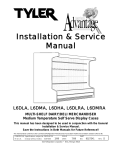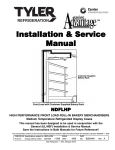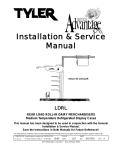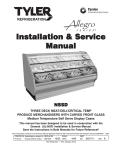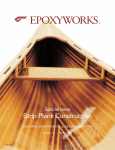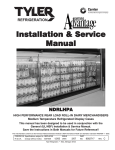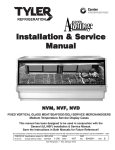Download Installation & Service Manual
Transcript
Installation & Service Manual LDFL FRONT LOAD ROLL-IN DAIRY MERCHANDISERS Medium Temperature Refrigerated Display Cases This manual has been designed to be used in conjunction with the General Installation & Service Manual. Save the Instructions in Both Manuals for Future Reference!! This merchandiser conforms to the Commercial Refrigeration Manufacturers Association Health and Sanitation standard CRS-S1-96. PRINTED IN Specifications subject to REPLACES IN U.S.A. change without notice. EDITION 5/04 ISSUE DATE 12/05 Tyler Refrigeration * Niles, Michigan 49120 PART NO. 9027545 REV. C Installation & Service Manual LDFL CONTENTS Page Specifications LDFL Specification Sheets . . . . . . . . . . . . . . . . . . . . . . . . . . . . . . . 4 Pre-Installation Responsibilities . . . . . . . . . . . (See General I&S Manual) Installation Procedures Carpentry Procedures . . . . . . . . . . . . . . . . . . . . . . . . . . . . . . . . . 6 Leveling the Cases . . . . . . . . . . . . . . . . . . . . . . . . . . . . . . . . . . . . . 6 Joining Cases . . . . . . . . . . . . . . . . . . . . . . . . . . . . . . . . . . . . . . . . 6 Sealing Joints . . . . . . . . . . . . . . . . . . . . . . . . . . . . . . . . . . . . . . . . 6 Special Instructions . . . . . . . . . . . . . . . . . . . . . . . . . . . . . . . . . . . . 6 Refrigeration Procedures . . . . . . . . . . . (See General I&S Manual) Patch Ends . . . . . . . . . . . . . . . . . . . . . . . . . . . . . . . . . . . . . . . . . . 9 Supporting Cases From the Building . . . . . . . . . . . . . . . . . . . . 10 Joint Trim Filler Kit . . . . . . . . . . . . . . . . . . . . . . . . . . . . . . . . . . . . 13 Patch End Joint Trim Assembly Filler Kit . . . . . . . . . . . . . . . . . . . . 14 Hood Assembly . . . . . . . . . . . . . . . . . . . . . . . . . . . . . . . . . . . . . . 15 Shelving and Shelf Base Installation . . . . . . . . . . . . . . . . . . . . . 16 Installation Procedure Check Lists . . . . (See General I&S Manual) Wiring Diagrams . . . . . . . . . . . . . . . . . . . . . . . . . . . . . . . . . . . . . . . . . . 16 LDFL Domestic & Export (50Hz) 8’ Case Circuits . . . . . . . . . . . . . 17 LDFL Domestic & Export (50Hz) 12’ Case Circuits . . . . . . . . . . . . 18 Cleaning and Sanitation . . . . . . . . . . . . . . . . . . (See General I&S Manual) Parts Information Operational Parts List . . . . . . . . . . . . . . . . . . . . . . . . . . . . . . . . . 19 Cladding and Trim Parts List . . . . . . . . . . . . . . . . . . . . . . . . . . . 20 TYLER Warranty . . . . . . . . . . . . . . . . . . . . . . . (See General I&S Manual) The following Medium Temperature Front Load Roll-In Dairy Merchandiser models are covered in this manual: MODELS DESCRIPTION LDFL 8’ & 12’ FRONT LOAD ROLL-IN DAIRY MERCHANDISER May, 2004 Page 3 LDFL Tyler Refrigeration SPECIFICATIONS LDFL Front Load Roll-In Dairy Merchandiser Specification Sheets Page 4 May, 2004 Installation & Service Manual May, 2004 LDFL Page 5 LDFL Tyler Refrigeration INSTALLATION PROCEDURES Sealing Joints Carpentry Procedures Tubes of caulking compound are furnished in the blister pack. The best time to make a waterproof case joint is at installation. It is recommended that two beads of caulking be used, one inside of the foam gasket for sanitation and one outside of the foam gasket for refrigeration. For an added measure of sealing, air-conditioning/heating duct tape can be used under inside joint trims. Leveling the Cases Check the levelness of the floor area to be used. The floor surface where this case is to be located should be as smooth and level as possible. Be sure there are no large bumps or dips in the floor. Insert shims under the case where necessary. The highest area of the line-up will have to be the determining high level point. The cases can then be leveled and joined from a level case at the high point. Level cases are necessary for both case pull-ups and proper operation. Small metal shims are furnished in the pull-up parts kit. Joining Cases Pull-up parts are shipped with the case in a “Blister-pack”. A list of parts furnished and where they are used is in the pack. Not all parts may be necessary for a particular case. Access panels must be removed to install pull-up hardware. CAUTION See “General I&S Manual” for proper refrigeration line installation and sealing. Special Instructions Be sure to read and understand the special instructions on handling these cases in this manual. Pay particular attention to the sections dealing with the anchoring of these cases to walls and/or roof structures. WARNING These cases are top heavy and require two or more people to move and/or position them. Improper handling of these cases could result in personal injury. 1. Remove the items packed on the skid. Cases must be pushed together as close as possible before pulling them together with the pull-up bolt hardware. Pull-up angles in the cases are factory installed for ease of field installation. Adjacent foam cases in a line-up may require different amounts of shimming to bring the cases into proper alignment. Joint and end trims are shown elsewhere in this manual. Follow these instructions to complete assembly of these cases. Patch ends are shipped loose because of shipping height limitations. Patch end kit drawings are provided in this manual. 2. Carefully raise the case (1) by tilting forward far enough to get enough clearance for the rear wall extension (2). Page 6 May, 2004 Installation & Service Manual 3. Apply the grey pressure sensative gasket (3) on both sides of the black foam gasket on the rear wall extension (2). 4. Install the rear wall extension (2) to the bottom of the case (1) with four bolts (4), washers (5) and nuts (6). 5. Install drain extension (7) on the bottom of the case (1) and secure with a hose clamp (8). LDFL 6. Move the case against the wall where it is to be located. Raise the telescoping extensions (9) and secure the case to the wall (or specifically designed structure). 7. Remove the rest of the skid. 8. Pilot drill 3/16” holes in rear wall extension (2) and install the base cladding (10) with self tapping screws. 9. Install joint trims and pull-ups per joint trim kit drawing. 10. Install patch ends per the patch end kit drawing. May, 2004 Page 7 LDFL Tyler Refrigeration NOTE Since the top panel is the service access panel for fans and refrigeration lines, it must be kept clear. Waste Outlet - Floor Drain The preferred method is an in floor drain. Position drain so floor sweepings can not be swept into the drain. The alternate method is a flush drain, where permitted. NOTE: Do not slope floors, since trucks need a flat platform. Page 8 IMPORTANT The information herein is only a general recommendation since store structures vary in strength and design. It is therefore necessary that the installing contractor and user assure themselves of the structural integrity of a chosen means of supporting these cases. TYLER can assume no liability for the consequences which may result from failure of structures or structural connections between this case and parts of a building. May, 2004 Installation & Service Manual LDFL Patch Ends A single case is self-supporting with the ends carrying the weight. Shipping height limitations make it necessary to ship the case without ends. They must be installed on location after the rear wall extension is added to the case. One inch structural partitions are available for use on line-ups. The one inch structural partition can be used between every case so that the entire line-up will be self-supporting. A drawback is that the partitions limit flexibility. The recommended method of supporting cases calls for supporting the cases from existing or specially constructed structures. Copy of label attached to each front load air skreen display case. IMPORTANT NOTICE This case was designed to provide a high degree of display flexibility in shelving and in roll-in carts. The base structure has been eliminated, making the merchandiser dependent upon support from walls and/or roof members. Single 8’ or 12’ cases can also be supported from patch ends. When two or more cases are to be installed and assembled, the cases must be attached to structural walls and/or structural portions of the roof . This meets the case weight requirement of 150 lb. per lineal foot . WARNING If this case is part of a line-up that requires disassembly, use great care during disassembly. The case line-up is not self-supporting and could injure or cause death if it fell. May, 2004 Page 9 LDFL Tyler Refrigeration Support Cases From The Building Installing cases in a continuous line-up to support the cases and to carry all possible additional shelving loads can be done in several ways: 1. A case line-up can be set close to a wall and gain support from it. IMPORTANT The information herein is only a general recommendation since store structures vary in strength and design. It is therefore necessary that the installing contractor and user assure themselves of the structural integrity of a chosen means of supporting these cases. TYLER can assume no liability for the consequences which may result from failure of structures or structural connections between this case and parts of a building. 2. When no building wall is available, the case may be cable attached to the roof structure. Truss work might also be used. There are pre-drilled holes on the ends of each case so that 3/8” eyebolts or other bolts (up to 1/2”) can be used. 1/4” cable with a minumum 2000 lb. tensile strength is recommended. The base must be anchored to the floor and sway bars as necessary must be used. 3. Columns may be run from floor to ceiling with a girder for case attachment. 4. Overhead structures can be used to support the cases and/or store decor from above. Page 10 May, 2004 Installation & Service Manual LDFL Rear column mounted in concrete Line-up may be supported by various beam details Case has back and top May, 2004 LDFL suspension system rear mounted column Page 11 LDFL Tyler Refrigeration Page 12 May, 2004 Installation & Service Manual LDFL May, 2004 Page 13 LDFL Tyler Refrigeration Page 14 May, 2004 Installation & Service Manual LDFL Hood Assembly WARNING Make sure all power is off to the case. Electrical servicing should always be done by a qualified electrician. Improper servicing could result in product damage and/or personal injury. 1. Pull the 3-prong female receptacle (1) through the hood extension weld assembly (2). 5. Swing the light channel assembly (5) up into place and secure with truss head screws (8). 2. Fasten hood extension weld assembly (2) to the canopy (3) with tappit screws (4). 6. Install top front cladding (9) over ballast (10) with screws (11). 3. Hook the light channel assembly (5) into the front lip of the front hood (6). 7. Complete the assembly by installing the hood extension joint trim (12) with truss head screws (13). 4. Plug the light channel wire (7) into the female receptacle (1). May, 2004 Page 15 LDFL Tyler Refrigeration Shelving and Shelf Base Installation When 48” shelving is to be used, installation is as in conventional cases. 24” and 48” shelf bases can be used, or shelves can be mounted above roll-in carts. If 24” shelves are used, it is necessary to attach uprights at a 24” spacing as shown to the right. The uprights are symetrical so they can be used for right or left hand applications just by reversing them. Pilot drill 3/16” on a line 3 1/4” down from the top. This also coincides with the centerline of the top slot on the built-in shelving uprights. Attach the uprights with the provided hex head screws at top and bottom using the upper hole in each pair of holes in the upright. Shelf Bases Shelf bases are 24” or 48” wide. Fronts for the shelf bases are 24, 48, 96 or 144” wide. Front ducts attach to the bases with “Hedlok” fasteners. These plastic interlocking devices provide easy removal, yet hold the front ducts securely. Just pry up to remove. Push in place to install. WIRING DIAGRAM ELECTRICIAN NOTE - OVERCURRENT PROTECTION 120V circuits should be protected by 15 or 20 Amp devices per the requirements noted on the cabinet nameplate or the National Electrical Code, Canadian Electrical Code - Part 1, Section 28. 208V defrost circuits employ No. 12 AWG field wire leads for field connections. On remote cases intended for end to end line-ups, bonding for ground may rely upon the pull-up bolts. Page 16 May, 2004 LDFL Domestic & Export (50Hz) 8’ Case Circuits May, 2004 Page 17 LDFL Domestic & Export (50Hz) 12’ Case Circuits Page 18 May, 2004 Installation & Service Manual LDFL PARTS INFORMATION Operational Parts List Case Usage Electrical Circuit Domestic 115 Volt 60 Hertz Export 220 Volt 50 Hertz Case Size 8’ 12’ 8’ 12’ Fan Motor 5243498 9 Watt 5243498 9 Watt 9458942 18.3 Watt 9458942 18.3 Watt Fan Motor Brackets 5205112 5205112 5205112 5205112 Fan Blades (8.75” 31° 3B) 5104858 5104858 ---- ---- ---- ---- 5054140 5154140 Fan Bracket Plate 9041077 9041077 9041077 9041077 Opt. ECM Fan Motor 9025000 12 Watt 9025000 12 Watt ---- ---- Opt. ECM Fan Motor Brackets 5205112 5205112 ---- ---- Opt. ECM Fan Blades (8.75” 30° 5B) 5187551 5187551 ---- ---- T-8 Lamp Ballast (canopy) (1st & 2nd row) 5966635 5991030 9322288 9322287 5991029 5991030 9322286 9322287 5204769 5049140 5204859 5204859 5049140 5049140 5989796 5989796 T-8 Lampholder (canopy) 5232279 5232279 5232279 5232279 800MA Lampholder (canopy) (telescoping) 5614628 5614628 5614628 5614628 5614629 5614629 5614629 5614629 Light Switch (SPST) 5100565 5100565 5100565 5100565 Anti-Sweat Heater (air grid retainer) 5124818 5124819 5081149 5081150 (8.75” 26° 3B) (3rd row) Opt. 800MA Lamp Ballast (canopy)(1st & 2nd row) (3rd row) (stationary) For information on operational parts not listed above contact the TYLER Service Parts Department. December, 2005 Page 19 LDFL Tyler Refrigeration Cladding and Trim Parts List Item Description LDFL 8’ 12’ 1309067 (9) 1309067 (12) 9026544 9026546 5183536 (5) 5183536 (5) 1 Screw (per close-off panel assy) 2 Close-off Panel Assembly 3 Screw (per top cover) 4 Top Cover 5186277 5186278 5 Lower Close-off Panel 9026548 9026548 5183536 (2) 5183536 (2) 9026544 9026546 Screw (per close-off panel assy) 1309067 (9) 1309067 (12) 7 Screw (per canopy) 5183536 (4) 5183536 (6) 8 Front Canopy Hood, Painted 9025223 9025224 9 Canopy Hood Backer, Painted 9025983 9025983 10 Screw (per backer) 5205439 (2) 5205439 (2) 11 Standard Hood Joint Trim 5222015 5222015 Short Hood Joint Trim 5222048 5222048 5205439 (6) 5205439 (6) Screw (per lower close-off) 6 Close-off Panel Assembly 12 Screw (per hood joint trim) 13 Light Channel Joint Trim 5222014 5222014 14 Bumper Retainer 9025504 9025506 15 Color Band, Painted NA NA 16 Color Band Backer, Painted NA NA 17 Bumper End Trim ---- color by order ---- 18 Bumper Backer ---- color by order ---- 19 Bumper ---- color by order ---- 20 Front Lower Cladding, Painted NA NA 21 Rivet (per lower cladding) 5104702 (6) 5104702 (6) 22 Shoulder Screw (per lower cladding) 9025833 (16) 9025833 (24) 23 Base Extension Assembly 5055027 5055028 Foam Base Extension 5054973 5054974 Reinforcement Channel 5055031 5055032 24 Screw (per channel) 1309067 (6) 1309067 (8) 25 Screw (per cart stop joint trim) 5205439 (2) 5205439 (2) 26 Cart Stop Joint Trim 5184553 5184553 27 Cart Stop Assembly 5184559 5184560 28 Screw (per cart stop assembly) 5183536 (6) 5183536 (10) 29 Raceway Cover 5184498 5184499 5111197 (7) 5111197 (9) 5184500 5184501 Screw (per raceway cover) 30 Raceway Assembly Page 20 May, 2004 Installation & Service Manual LDFL Item Description 31 Screw (per raceway assembly) 8’ 5183536 (6) 12’ 5183536 (8) 32 Screw (raceway cover plate) 5111197 (7) 5111197 (9) 33 Raceway Cover Plate 5184497 (2) 5184497 (2) 34 Nut (per end spacers) 5100634 (2) 5100634 (2) 35 Lock Washer (per end spacers) 5101006 (2) 5101006 (2) 36 Flat Washer (per end spacers) 5100979 (4) 5100979 (4) 37 Machine Screw (per end spacers) 5107443 (2) 5107443 (2) 38 Nut (per end spacers) 5100643 (6) 5100643 (6) 39 Lock Washer (per end spacers) 5628631 (6) 5628631 (6) 40 Flat Washer (per end spacers) 5100982 (12) 5100982 (12) 41 Machine Screw (per end spacers) 5120913 (6) 5120913 (6) 42 Rivet (per end spacers) 5105037 (8) 5105037 (8) 43 End Spacer 5184602 (2) 5184602 (2) May, 2004 Page 21






















